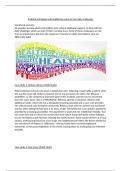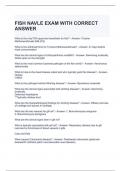Enabling individuals with additional needs to face daily challenges
Vocational scenario:
All societies include adults and children who require additional support, to deal with the
daily challenges which are part of their everyday lives. Some of these challenges are not
from an impairment, but from the response of society to adults and children who are
differently abled.
Case study 1: Rebecca Brown (Child Study)
Rebecca Brown is 8 years old and is a wheelchair user, following a road traffic accident when
she was five years old. Rebecca requires one to one personal care due to her physical
disabilities, as she sustained a fractured spine in the accident, and she has no movement
from her waist down. She is a PARAPLEGIC. Rebecca attends a school for children with
additional needs, where she has a designated teaching assistant and a carer who provides
her with personal care during the school day. Rebecca lives with her parents Sue and David
and her older sibling Michael who is 12 years of age. The family live in an upstairs apartment
provided by a housing association. The apartment is small and not ‘wheelchair friendly.’ Sue
has a part time job at a local day nursery but must stay at home during the school holidays,
to care for Rebecca and Michael, reducing the family income. David works full-time at a local
factory, working long hours for a low wage. The neighbourhood where the Brown family live
are not tolerant of Rebecca’s ‘difference,’ and the family have received unpleasant
comments as they pass neighbours in the street, causing them to avoid going out whenever
possible.
Case study 2: Ben Grace (Adult Study)
,Ben Grace is fifty-two and has Down’s syndrome and type 2 diabetes. Ben has a learning age
of 8 and requires support with all aspects of daily living. Ben lives in a group setting with five
other adults who have learning difficulties and who also require additional support. Ben
previously lived with his mother, but following her death last year, Ben moved to the
residential setting has always enjoyed going shopping, but since he has moved into the
residence, he prefers to stay in his room which is a concern for the staff, following an
incident with some local youths who shouted at Ben when he went shopping with the
residents and carers. Recently Ben was refused entry to a local funfair by the manager who
stated that Ben’s appearance could prevent other people wanting to attend. Ben is refusing
to keep to the special diet required to control his type 2 diabetes and staff have found bags
of sweets under his pillow when making his bed. His blood glucose levels are unstable,
resulting in Ben feeling unwell. Ben has become withdrawn.
Reasons why individuals may experience addition needs
Rebecca has had an accident which caused her to be paraplegic, the term "paraplegia"
refers to the inability of the lower body to move on its own. The abdomen may or may not
be among the areas of reduced movement, along with the toes, feet, and legs. Her parents
work which makes it difficult for her to do daily tasks alone when her career is not available.
Her condition can get controlled and be easier to deal with if her parents are able to move
to a new house/apartment which is wheelchair friendly with elevators handles, low tables
and desks, this will make it easier for her to assess things herself with more realisability on
herself when her carer or parents cannot be around her. However, there is no cure for
paraplegia and in Rebecca’s case it could be harder to deal with as she lives in an unfriendly
wheelchair service apartment.
Ben has down syndrome and type 2 diabetes, down syndrome is a condition wherein an
individual carries an extra chromosome. In the body, chromosomes are discrete "packages"
of genes. They control how a baby's body develops during pregnancy and after birth,
determining how it will look and work. A new-born typically has 46 chromosomes.
Individuals with down syndrome may have varying degrees of intellectual disability and
developmental delays. It is the most prevalent genetic chromosomal defect and the root of
children's learning problems. It frequently results in other medical issues as well, such as
cardiac and gastrointestinal problems. Type 2 diabetes is a condition that causes a disorder
in the body's ability to control and utilise sugar (glucose) as fuel is type 2 diabetes. This
chronic (long-term) disorder causes the bloodstream to circulate with an excessive amount
of sugar. Over time, cardiovascular, neurological, and immune system issues might result
from excessive blood sugar levels. Type 2 diabetes there is no cure for type 2 diabetes other
than losing weight, eating well, and exercising. Ben’s down syndrome condition cannot be
cured however it can get worse over time due to his type 2 diabetes which has a plan
prepared to control it, but he is not following it. This will also cause his diabetes to ger
worse, and his condition can be life threatening.
Source:
, https://www.cdc.gov/ncbddd/birthdefects/downsyndrome.html
https://www.healthline.com/health/body/paraplegia
The diagnostic procedures, tools and standards used to diagnose their additional needs
After the accident that Rebecca went through, she would have been sent to a hospital and a
variety of specialised procedures, such as MRIs (Magnetic Resonance Imaging) of the brain
and spine, analyses of the cerebrospinal fluid, nerve conduction tests, and an EMG, may be
utilised to make the diagnosis. Genetic testing might also be required in specific
circumstances all to help Rebecca in her condition to find out how fatal her condition is.
After that has been done and the level of danger Rebecca is in is being covered people such
as physiotherapy to help Rebecca maintain as much strength and muscle mass as she can,
occupational therapist to help adapt Rebecca’s home so everyday tasks like dressing and
cooking are easier. Rebecca will also receive support from foundations and charities such
disabled living foundation, GOV.UK: help and advice for disabled people. Rebecca will also
get regular appointments from the GP and her doctor to keep up to date with her condition
and to make sure her needs are met. A multidisciplinary team's support is necessary for the
complicated procedure of diagnosing paraplegia. The team often consists of radiologists,
orthopaedic surgeons, physical therapists, neurologists, and other experts. The
identification of Rebecca's paraplegia is a crucial first step in creating a management
strategy. The doctor will first try to identify what caused Rebeca's accident and any spinal
cord damage. The sort of care Rebecca with paraplegia need will frequently be determined
by the diagnosis process, which is crucial. Her doctor will first review her medical history and
record any current or previous medical issues she may have. After reviewing Rebecca's
medical history, a physical examination will be performed, with a focus on her lower body's
functionality. To learn more about her health, doctors will prescribe exams including x-rays,
CT scans, and MRI scans.
Source:
https://www.nhs.uk/conditions/paralysis/
https://www.medicalnewstoday.com/articles/what-is-paraplegia
Ben who is 52 years old is diagnosed with down syndrome and type 2 diabetes, illness that
can present people with unique difficulties and prognoses is down syndrome, especially in
the formative years. Down syndrome, a genetic disorder brought on by the addition of one
chromosome, can cause a variety of mental and physical symptoms. The stability and
evolution of Ben's symptoms can vary greatly, with some people being quite independent
and others needing lifelong care. To develop specialised support networks and foster
positive outcomes for those affected by Down syndrome, it is essential to have a complete
understanding of the intricacies associated with this disease. For Ben's condition to remain
stable over time, it is frequently necessary for him to have access to the right medical
treatment, educational materials, and supporting surroundings. A chronic disease known as
type 2 diabetes is characterised by the body's ineffective use of insulin, which raises blood
sugar levels. Insulin is a vital hormone that controls how much glucose is taken in by our
cells, which is important for generating energy. Obesity and a sedentary lifestyle, as well as
a genetic tendency that is particularly prevalent in Ben and other individuals with Down
syndrome, are the usual causes of this insulin resistance. For Ben with Down syndrome,





